Trees Birds Mammals Fish Amphibians Reptiles
Wild Algarve
Bookshop
Laetiporus sulphureus (Bull.) Murrill - Chicken-of-the-Woods
Phylum: Basidiomycota - Class: Agaricomycetes - Order: Polyporales - Family: Polyporaceae
Distribution - Taxonomic History - Etymology - Identification - Culinary Notes - Reference Sources
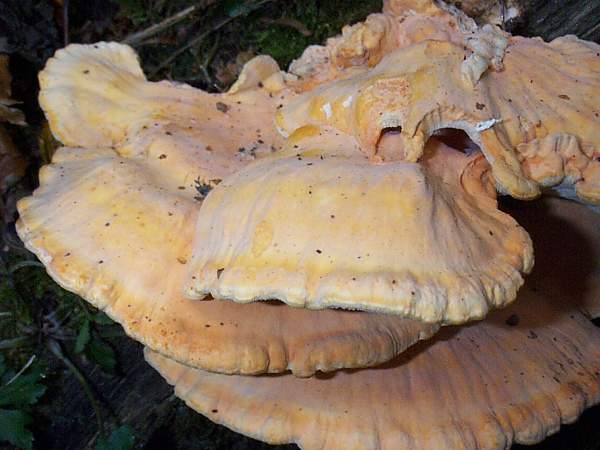
Laetiporus sulphureus, with its strident orange or sulphur-yellow colouring,
is hard to miss. Known as Chicken-of-the-Woods or the Sulphur Polypore, this
bracket fungus is seen most often on beech, oak, chestnut and less frequently on cherry and other hardwoods. Only rarely are these impressive fungi associated with conifers other than Yew.
Sometimes, specimens of this large polypore
persist through the winter and are able to continue fruiting during the following year.
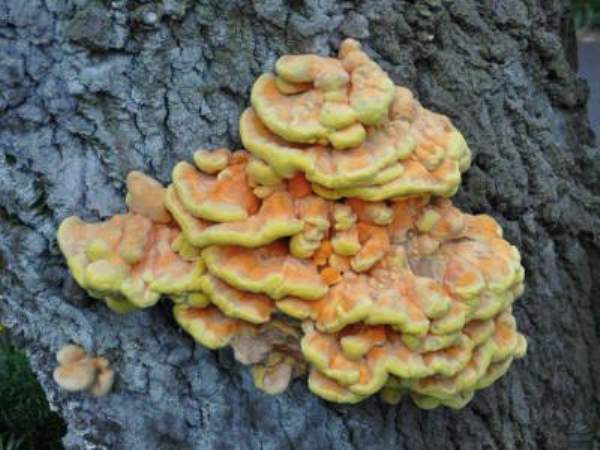
The specimens shown above are young and their flesh is tender; with age they become tougher before collapsing and decaying into a blackish mush.
Distribution
Infrequent in many parts of Britain and Ireland, Chicken-of-the Woods is locally common and sometimes a real pest in Yew woodlands. This or very similar species also occur across northern Europe and in some parts of the USA.
Although usually seen on standing trunks of trees this polypore also grows on fallen trunks and less frequently on large detached branches.
Taxonomic history
Originally described in 1789 by French botanist and mycologist Jean Baptiste Francois (Pierre) Bulliard, this spectacular polypore was given its current name in 1920 by the famous American mycologist William Alphonso Murrill (1869 - 1967).
Etymology
The specific epithet sulphureus is a reference to the sulphur-yellow colouring of fruitbodies of this polypore, while the genus name Laetiporus means 'with bright pores'.
Identification guide
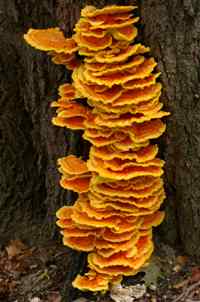 |
Caps
The wavy-edged young brackets are soft and
spongy with broad margins, but as they age the margins become thinner and
paler. (Picture: Doug Holland)
Individual brackets range in width from 10 to 40cm and vary from 3 to
12cm in thickness. Their colours vary from egg yellow to pale creamy
yellow with pink and orange tinged bands.
The flesh is yellow-orange when moist, drying out paler. |
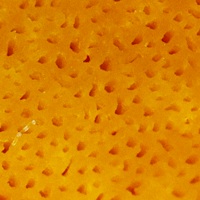 |
Tubes and Pores
Underneath the brackets there are tiny roundish
or ovalish tubes - typically 2 or 3 per mm and 15 to 30mm deep. The pores
are white or pale yellow. |
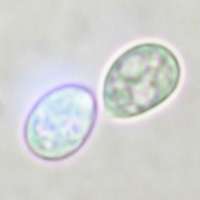 |
Spores
Ellipsoidal to broadly ovoid, 5-7 x 3.5-4.5µm.
Spore print
White. |
Odour/taste |
Smells 'mushroomy'; slightly sour taste. |
Habitat & Ecological role |
Chicken-of-the-Woods is saprobic, feeding on dead or dying hardwood timber, mainly oak,
sweet chestnut, beech and occasionally cherry and willow. Surprisingly, this conspicuous bracket fungus also occurs on yew trees, which are of course conifers. |
Season |
Summer and autumn in Britain and Ireland. |
Similar species |
Laetiporus sulphureus could possibly be confused with pale specimens of the Giant Polypore, Meripilus
giganteus, which is distinguished by the fact that its pores turn black when
bruised. |
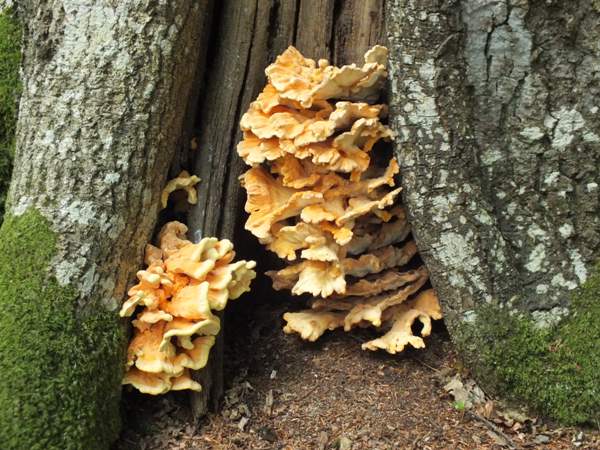
Culinary notes
Laetiporus sulphureus is generally rated as a good
edible fungus (unless growing on wood such as Yew, which itself contains dangerous toxins that could be taken up by the fungus); however, it is best picked when young and moist.
A popular way of cooking this fungus is to cut it into
slices, brush them with oil, and then fry them in breadcrumbs; serve with
lemon juice. The taste is quite like chicken; however, although most people find this a good edible species a
small minority find that it causes feelings of nausea. If frozen (uncooked), this fungus retains most of its flavour, and so
it is a good species for storing in preparation for the winter months.
Reference Sources
Mattheck, C., and Weber, K. Manual of Wood Decays in Trees. Arboricultural Association 2003.
Fascinated by Fungi, 2nd Edition, Pat O'Reilly 2016, reprinted by Coch-y-bonddu Books in 2022.
Dictionary of the Fungi; Paul M. Kirk, Paul F. Cannon, David W. Minter and J. A. Stalpers; CABI, 2008
Taxonomic history and synonym information on these pages is drawn from many sources but in particular from the British Mycological Society's GB Checklist of Fungi.
Acknowledgements
This page includes pictures kindly contributed by James Wainscoat.
Top of page...
Fascinated by Fungi. Back by popular demand, Pat O'Reilly's best-selling 450-page hardback book is available now. The latest second edition was republished with a sparkling new cover design in September 2022 by Coch-y-Bonddu Books. Full details and copies are available from the publisher's online bookshop...